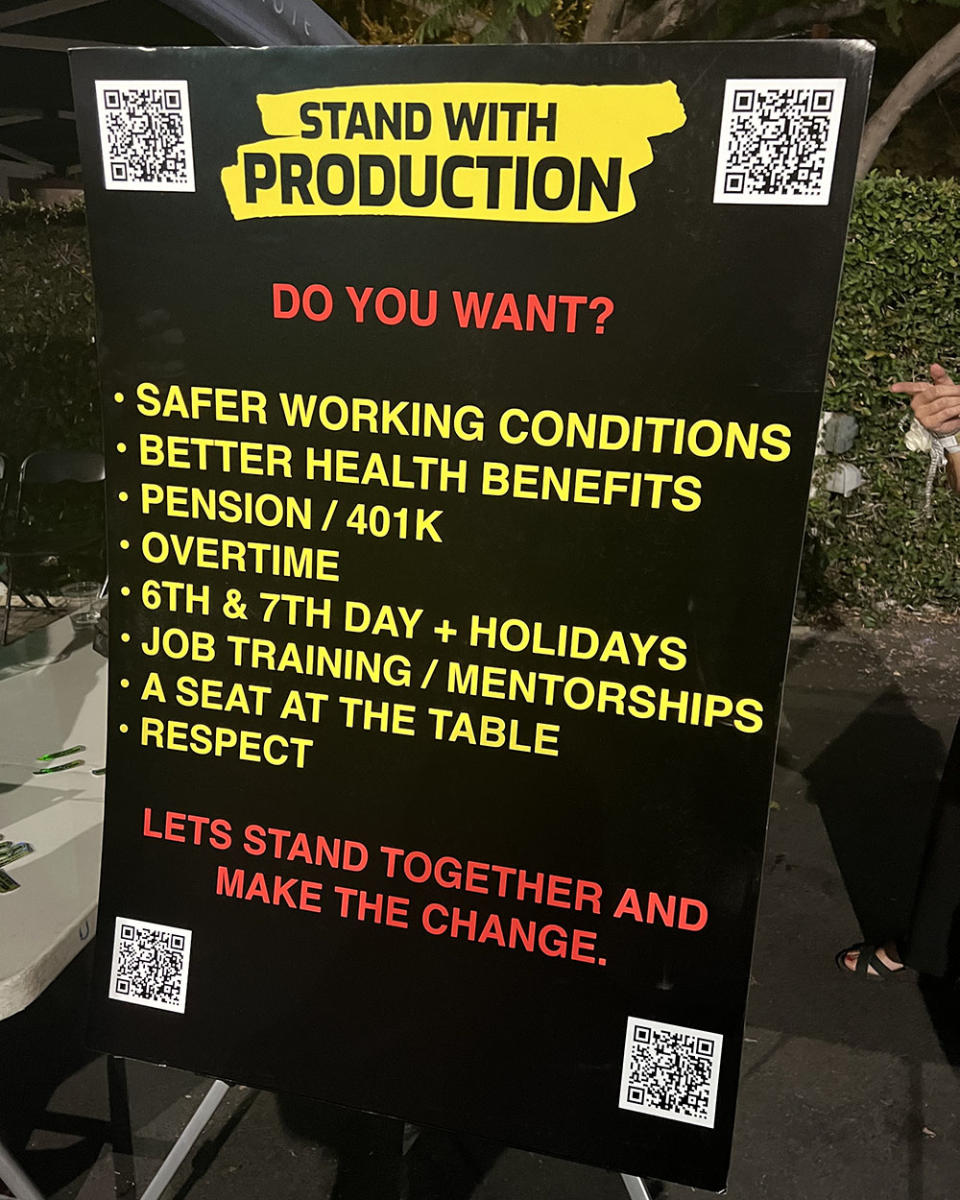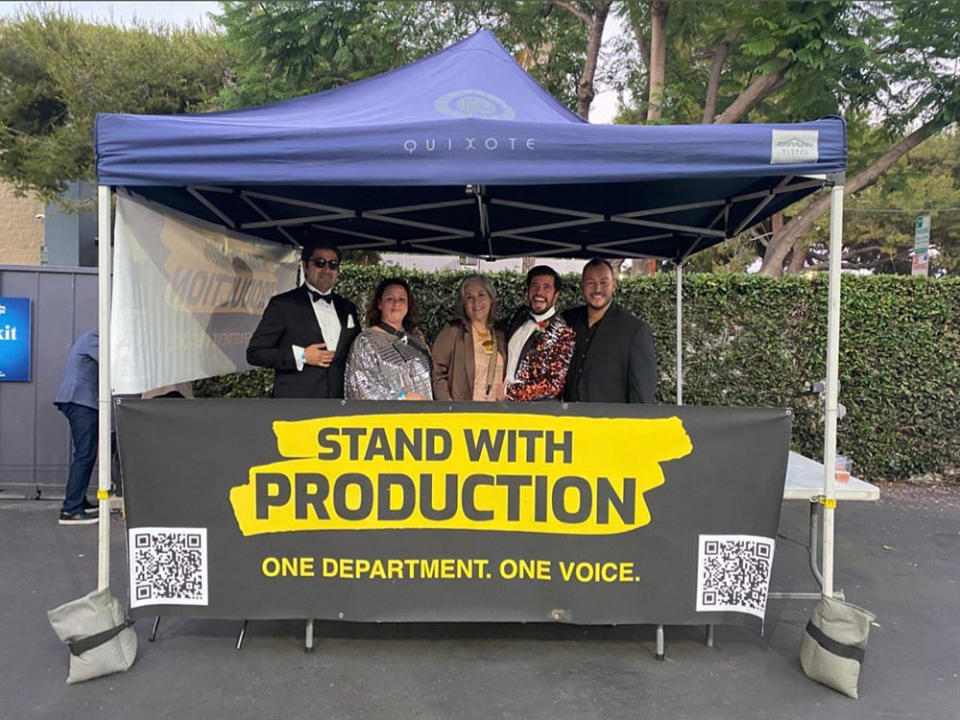After Commercial Walk-Off, a Major Union Drive for Production Workers Begins

Over the course of a few days in October 2021, as they were watching film and TV crewmembers unionized with IATSE threatening to strike, a producer and production supervisor working on a major commercial job contemplated taking their own stand.
Erin Wile and Cheyenne Cage were working on a multimillion-dollar ad campaign for a major tech company that was pushing them to their breaking point: The production required long hours and lengthy commute times, coordinating several shoots and navigating the threat of bad weather, all while the production team was being asked to put more on their plate. (Wile and Cage declined to publicly name the companies involved, but The Hollywood Reporter confirmed the details of the shoot with other workers on the project.) Finally, three days into the shoot and after they say they raised concerns that weren’t addressed, Wile and Cage walked off the job, and the project’s assistant production supervisor, production assistants, COVID compliance team and script supervisor followed suit.
More from The Hollywood Reporter
Second Activision Blizzard Worker Group Launches Union Drive With CWA
Directors Guild Scales Up Health Plan Coverage for Abortion Services
Hollywood Guilds, Studios Extend COVID Protocols With Two Modifications
It was a big decision, considering that production teams on commercials are not unionized and a number of these workers rely on close relationships with companies to procure work. Cage forwarded an email she sent to the executive producer of the campaign, which called for “humane and fair treatment” to a number of colleagues, and soon the story of this rare production-team walk-off began to circulate widely. Cage says she and Wile received “hundreds” of emails and many phone calls about their action. To keep the conversation about work conditions going, the pair hosted a virtual “town hall” the next week, which was attended by hundreds. “Erin and I were like, OK, something’s happening now,” Cage says. “From there, we continued to host town halls that slowly became more and more about organizing.”
So began Stand With Production, a grassroots worker group founded by Wile and Cage that is now attempting to unionize members of production departments on TV commercials with IATSE. The group, which is going public on Thursday with its unionization effort, is seeking to fold production assistants, assistant production supervisors, production supervisors, line producers and bidding producers into a national union. They are currently gathering union authorization cards and ultimately want to request voluntary recognition from the Association of Independent Commercial Producers (AICP), which negotiates on behalf of independent commercial production and postproduction companies with labor unions, but haven’t reached out with the ask yet. (The AICP declined to comment at this time.)

Courtesy of StandWithProduction
Stand With Production came to the decision to attempt unionization gradually. After the group’s initial town hall in 2021, more virtual gatherings followed, and Wile and Cage started speaking one-on-one with production department workers, who typically handle the logistics of TV commercial shoots while managing the budget and communications with the project’s production company, agency and client. Inspired by one of those conversations, a group of Stand With Production members penned a set of “production guidelines” detailing labor standards for production departments that the group believes should be implemented industry-wide. The guidelines propose daily pay rates the group finds acceptable and how those rates could rise with cost-of-living increases; they also provide suggestions for how workers clocking more than 12 hours a day and/or working six or seven consecutive days in a week should be paid. Over 1,700 production workers and supporters in the industry signed a petition supporting the guidelines, and Stand With Production has encouraged its members to ask employers to honor the guidelines in job negotiations. (Initially, the group planned a walkout attached to the guidelines, but later scrapped that idea; still, the guidelines and the threat of a walkout “did give us a bit of political power” and increase pay rates for some workers, Wile says). Stand With Production also amassed a database of the names, contact information and the regions of thousands of workers in the field.
Late in 2021, a Stand With Production member began reaching out to a number of unions, including IATSE, to explore the group’s options. Still, sentiment on whether the group should unionize was mixed: Line producer Josh Jupiter notes he initially felt “very negative” about unionizing, while production assistant Hank Hartnell says he was skeptical about restricting group members to union work (both are now supporters of the IATSE union drive). Further, “I think the majority of the group felt that going with a Local was going to be hard because we’re spread out all over the country,” says Wile.
According to the group, multiple organizations including the Communications Workers of America expressed interest in talking to the group, but IATSE made the most convincing pitch for unionizing with their organization. The union offered to attempt to unionize all the roles that Stand With Production was bringing together, organize on a national scale and let Stand With Production helm the drive. (THR has reached out to CWA for comment.)
On IATSE’s end, it was somewhat out of the ordinary to land on a group that had already touched base with so many workers and compiled a list of desired labor standards. “It’s an unusual but welcome thing for this level of organization to exist prior to an actual unionization campaign,” says a source close to the union.
While Stand With Production organizers and supporters say the concerns they want to address with a union are chronic, those issues came to a head during the pandemic. Like the IATSE film and television members who authorized a strike in the fall of 2021, the group wants to establish greater rest periods, turnaround times and safety training, arguing that COVID-19 has exerted even more pressure than usual on their teams. Moreover, members say they would like to increase standard rates because their wages haven’t kept up with years of inflation; several of the roles the group would like to unionize are also currently ineligible for overtime. Supporters are seeking access to union health and pension plans (many AICP employers already offer certain nonunion freelance commercial workers health insurance via the Producers’ Health Benefits Plan, but according to Stand With Production members, its qualification requirements are steep). The group also hopes to establish diversity and inclusion and mentorship and training programs.
“The pandemic has really shown us all the cracks in our system,” Jupiter notes. He thinks a union can instill “respect for time and being realistic about what we as humans are capable of doing with our time.”
In a statement, IATSE international president Matthew Loeb noted that many issues the workers are hoping to address “are the very same ones this union has fought to address through collective bargaining for decades.” He added that many preexisting IATSE members work in commercials and “your [Stand With Production’s] fight is our fight.”
Still, Cage says that Stand With Production wants to preserve its members’ relationships with production companies and not engage in a “contentious battle” during organizing. Some roles Stand With Production and IATSE are looking to unionize — such as line producers, production supervisors and bidding producers — can be hired directly by production companies. Moreover, production workers on commercials frequently move from job to job, and as a result, many of them rely on close relationships with companies throughout their careers. The Stand With Production group says they consulted with some of these companies during their organizing: “We understand that everyone in commercials, regardless of their position, is under the gun,” says Kit Garchow, a Stand With Production founding member and assistant production supervisor. “[Employers are] getting unreasonable requests, which falls onto someone else, which falls onto us. And so what this movement does is it allows them to have a sure footing to push those unreasonable requests back up.”

Courtesy of StandWithProduction
This isn’t the first time that production workers on commercials have sought union coverage. A few years ago, production supervisors, assistant production supervisors and IATSE Local 871 argued in arbitration with the AICP that those roles should be covered under a sideletter in the Local’s commercial agreement. The workers involved were looking to resolve several of the same issues Stand With Production is now seeking to tackle: high demands on producers, short turnaround times and low wages, says Chris Valdez, a production supervisor who was involved in the effort at the time. By the start of the COVID-19 pandemic, sources tell THR, the effort failed, with the AICP fighting the cases that were brought and a dwindling amount of workers supporting the cause. The sideletter in question was removed in contract negotiations that occurred in 2019.
Based on his past experience attempting to gain coverage under a union agreement, Valdez was initially skeptical of the Stand With Production group. After meeting the organizers and learning IATSE was backing the TV commercials effort, though, he became a supporter. This time around, the drive has “got a great shot because it’s the last shot,” he says. “If it doesn’t happen now, it’s never going to happen. People are pushed to their extreme … so it’s all or nothing.”

